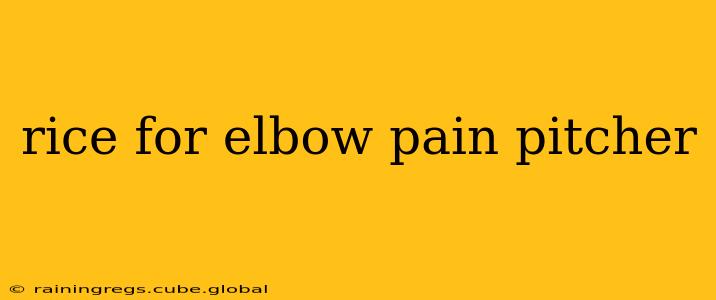Elbow pain is a common ailment, especially for pitchers who repeatedly stress their arm during intense throwing motions. Many pitchers seek natural and effective ways to manage this pain, and rice—rest, ice, compression, and elevation—is a widely recommended first-line treatment. This comprehensive guide will explore the benefits of RICE therapy for elbow pain in pitchers and answer common questions surrounding this approach.
What is RICE Therapy?
RICE therapy is a simple yet effective first-aid treatment for soft tissue injuries, including elbow pain. It involves four key components:
-
Rest: Avoiding activities that aggravate your elbow pain is crucial. This means taking a break from pitching and modifying your daily activities to minimize strain on the affected area. Listen to your body; pushing through pain will only worsen the injury.
-
Ice: Applying ice to your elbow reduces inflammation and numbs the pain. Ice for 15-20 minutes at a time, several times a day. Never apply ice directly to the skin; always wrap it in a thin cloth.
-
Compression: Using a compression bandage helps to reduce swelling and provide support to the elbow joint. Make sure the bandage isn't too tight, as this could restrict blood flow.
-
Elevation: Keeping your elbow elevated above your heart helps to reduce swelling by promoting fluid drainage. Try to keep your elbow elevated whenever possible, especially during rest periods.
How Does RICE Help Pitcher's Elbow?
Pitchers' elbows often suffer from conditions like medial epicondylitis (golfer's elbow) or lateral epicondylitis (tennis elbow), both involving inflammation of tendons. RICE therapy helps by:
- Reducing Inflammation: Ice and elevation are particularly effective in reducing inflammation, a primary cause of elbow pain.
- Minimizing Swelling: Compression and elevation work together to decrease swelling, relieving pressure on the affected tendons and nerves.
- Managing Pain: Ice provides temporary pain relief, allowing for better rest and recovery.
- Promoting Healing: Rest allows the injured tissues to repair themselves.
How Long Should I Use RICE for Elbow Pain?
The duration of RICE therapy depends on the severity of your elbow pain. For minor injuries, you may see improvement within a few days. However, more significant injuries might require several days or even weeks of RICE treatment. If your pain persists or worsens, consult a physician or physical therapist.
When Should I See a Doctor for Pitcher's Elbow?
It's important to seek medical attention if:
- Your pain is severe or doesn't improve with RICE therapy.
- You experience numbness, tingling, or weakness in your arm.
- You have a noticeable deformity or instability in your elbow.
- Your elbow pain is accompanied by fever or other systemic symptoms.
Is RICE Enough for Treating Pitcher's Elbow?
While RICE is an excellent first-aid treatment, it's rarely sufficient for fully recovering from pitcher's elbow. It's essential to combine RICE with other treatments, such as physical therapy, to restore strength, flexibility, and proper throwing mechanics. A physical therapist can provide tailored exercises to strengthen the muscles around your elbow and improve your biomechanics to prevent future injuries.
What Other Treatments Are Available for Pitcher's Elbow?
Beyond RICE and physical therapy, other treatments for pitcher's elbow include:
- Medication: Over-the-counter pain relievers (NSAIDs) can help manage pain and inflammation.
- Injections: Corticosteroid injections can provide temporary pain relief, but they aren't a long-term solution.
- Surgery: In severe cases, surgery may be necessary to repair damaged tendons or ligaments.
Can I Prevent Pitcher's Elbow?
Preventing pitcher's elbow requires a multifaceted approach:
- Proper Warm-up: Always warm up thoroughly before pitching to prepare your muscles and joints.
- Proper Throwing Mechanics: Work with a pitching coach to ensure you have proper throwing mechanics to minimize stress on your elbow.
- Strength Training: Focus on strengthening the muscles that support your elbow, particularly your forearms and rotator cuff muscles.
- Rest and Recovery: Adequate rest between pitching sessions is crucial for preventing overuse injuries.
By following these guidelines and prioritizing proactive care, pitchers can significantly reduce their risk of developing elbow pain and maintain a long and healthy pitching career. Remember, consulting a healthcare professional is vital for proper diagnosis and treatment of any persistent elbow pain.
